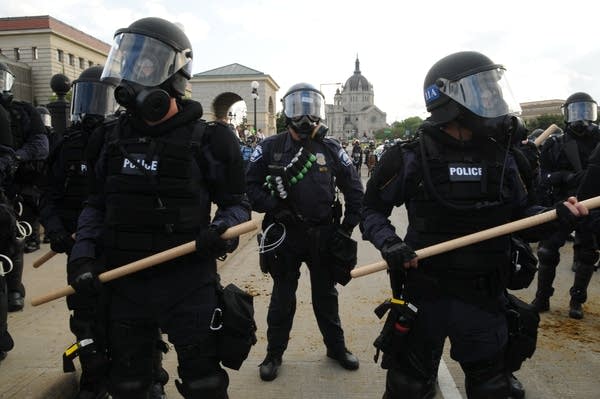Commission report on RNC police procedures offers mixed review
Go Deeper.
Create an account or log in to save stories.
Like this?
Thanks for liking this story! We have added it to a list of your favorite stories.

The commission found that one of the city's first missteps was how it described the convention to the public -- long before it even began.
"The vision that the city of St. Paul set for this convention, by the consensus of everyone we talked to, was that this would be 'a different convention,'" said former federal prosecutor Andy Luger, who co-chaired the commission.
Luger reminded the City Council that local officials promised to promote free speech and peaceful protests. It wasn't meant to be a joke, but that's how activists in the audience treated his remarks.

"Their attempt was to have a convention with a very soft and light police presence," he said, prompting laughter from the crowd.
Turn Up Your Support
MPR News helps you turn down the noise and build shared understanding. Turn up your support for this public resource and keep trusted journalism accessible to all.
Luger's co-chair, former U.S. Attorney Tom Heffelfinger, said the city's assurances of a warm and inviting convention were at odds with the real need to secure the city from self-described anarchists bent on violence and disruption.
"That open and welcoming style and methodology conflicted with an effective response to early anarchist conduct," Heffelfinger said.
The commission also found that St. Paul's security plan was inadequate to control the mayhem that broke out on the first day of the convention.

Police in riot gear, known as the mobile-field force, were supposed to stay together in their mini-vans when responding to a call. That strategy limited their mobility. And patrol officers weren't able to communicate directly with those units.
The report described the first day as "a game of whack-a-mole, in which police were always chasing, but never controlling, the anarchists."
Heffelfinger said the problem was never a shortage of officers. "The problem was, they weren't nimble or mobile enough," he said.
In addition, the report faults the police plan for focusing more on crowd control than the need to make "surgical arrests" of troublemakers. That shortcoming "contributed to the escalating violence on Sept. 1," the report said.
But the commission appeared at times sympathetic with the city. Heffelfinger noted that St. Paul was one of the smallest cities in recent years to host a national convention, which made recruiting officers from around the country a huge task.
"The attempt to plan, train and staff a coordinated and properly communicating effort was a significant challenge for a city this size. Prior conventions were in places like New York, one police department; L.A., one police department; Boston, maybe five police departments."
And St. Paul? Heffelfinger noted that 120 police departments from across the country were involved. He said that led to significant delays in preparing for the event.
The commission also observed that officers occasionally targeted individuals with pepper spray, rather than simply arresting them.
Another criticism was that the city lacked a clear policy on how to handle journalists. About 40 reporters were arrested while covering the story.
Day Four was especially controversial, as officers revamped their tactics. Hundreds of people were arrested on the Marion Street Bridge on that final night.
"There is an inconsistency as to what the police plan was," Heffelfinger said. "Was the police plan to 'wait out' the group? Or was the police plan to declare an unlawful assembly and arrest?"
But the report found that the police response was, for the most part, "justified and appropriate." It noted that peaceful protesters were allowed to broadcast their message far closer to the convention center than their counterparts in Denver during the Democratic convention.
Heffelfinger and Luger say findings of individual wrongdoing were outside of the scope of the review, as defined by the city.
Mayor Chris Coleman said the city will examine the commission's recommendations. St. Paul paid more than $100,000 for the review. The seven-member panel also included a former mayor, a law professor, and a former suburban police chief.
Activist Bill Drebenstedt says the commission should have gone farther.
"They should have been answering the question. 'Was excessive force used? Were the police abusing their authority?'" Drebenstedt said. "I think if they were looking at that question, the conclusion would have been, 'Yes, that did occur.' I think delving into that question has been purposely avoided, by both the City Council and the commission."
Police Chief John Harrington told reporters that the report's conclusions mirror some of the conversations he and his colleagues have had since the convention.
He acknowledged, for example, that the bulky gear of mobile-field force officers may have obscured their badge numbers, making it difficult to identify the officers. And, in hindsight, he added that the idea of keeping mobile-field force officers together in the minivans "maybe didn't give us the flexibility to ... get to places as fast as we would have wanted to."
Harrington added that he would be inclined to open investigations into specific cases in the report that questioned the use of chemical weapons on protesters.
But all in all, Harrington said the event was largely a success. The convention went without a hitch, and the delegates were safe.
"That's pretty amazing with the thousands of people that came down there ... and all the things that could have happened, very little did happen, in terms of violent activity," he said.
The police department plans to put out its own assessment of how it performed during the RNC by the end of the month.
Dear reader,
Political debates with family or friends can get heated. But what if there was a way to handle them better?
You can learn how to have civil political conversations with our new e-book!
Download our free e-book, Talking Sense: Have Hard Political Conversations, Better, and learn how to talk without the tension.




